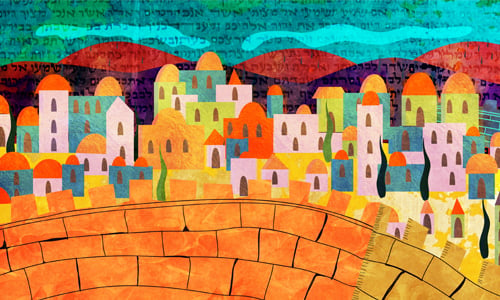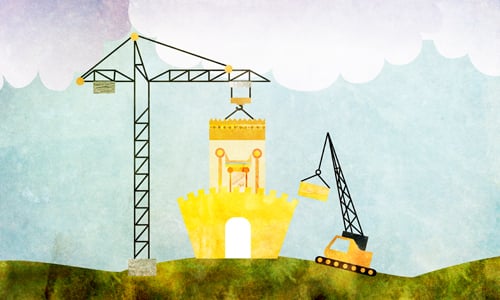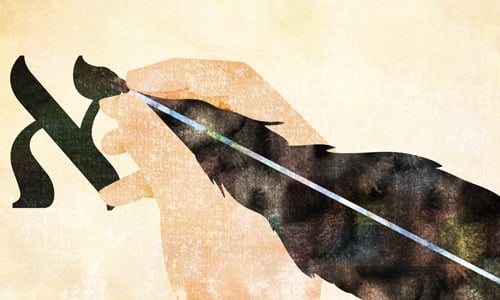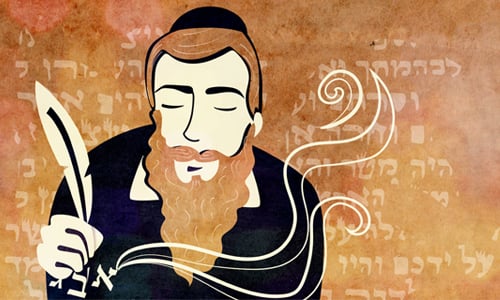Ezra the Scribe (Ezra HaSofer) led the second wave of Jews returning from Babylon to Israel. He headed the religious revival of the people there at the beginning of the Second Temple era. He also led the Men of the Great Assembly, one of the most influential groups of scholars in Jewish history.
Ezra’s Early Life
Very little is known about the early life of Ezra the Scribe. He was born in Babylon to a priestly family, and dedicated himself to the study of the Torah. By trade he was a scribe, writing books of the Torah and Prophets. He lived in Babylon for the first decades of his life, studying under Baruch ben Neriah.1
The First Return To Israel

Throughout the time period of the Babylonian exile, the Jews waited impatiently for the day that Babylonian or Persian2 kings would allow them to return to their land and rebuild the Temple. When Cyrus was appointed king, their efforts were finally rewarded.
Cyrus ordered that they be allowed to return to Israel and rebuild the Temple. He even promised to provide supplies for the project.3
Ecstatic, a large contingent of 42,360 people4 marched back to Israel, determined to rebuild the Temple and restore it to its former glory. They immediately laid the foundations, accompanied by the Levite orchestra and the cries of joy of the onlookers.5
The exhilaration was short-lived. The other inhabitants of the land, feeling threatened by the sudden mass immigration, opposed the project. They bribed officials to order a stop to the building, delaying the construction until the reign of Cyrus had ended. The next Persian king, Ahasuerus, was less amicable toward his Jewish subjects. Taking advantage of this, the inhabitants of Israel sent letters telling Ahasuerus that the Jews were planning a rebellion and spreading sedition. After reading those letters, the king halted the project.6
The status quo remained unchanged until Darius took over as the next Persian king. In the second year of his reign, the prophets Haggai and Zechariah commanded the Jews to resume the construction of the Temple. Zerubbabel and Jeshua ben Jehozadak took up the call and headed the rebuilding efforts.7
Once again, though, the news was not well accepted by the nearby inhabitants.8 King Darius was sent a report of their activities, and agreed to let them continue only after searching the archives and discovering that King Cyrus had originally supported the project.9 After Darius encouraged the building, it continued unabated until the Temple’s eventual completion four years later, on the third of Adar.10
Ezra himself had not gone with the first group of returnees to Israel. He stayed in Babylon throughout this period, either to continue his studies or in order to avoid any power struggles with Jeshua ben Jehozadak over the position of high priest.11
Once the first group had left, Ezra gained prominence in the Jewish community in Babylon. He began the process of identifying lineages, researching genealogies and forming detailed family lists. By the time he left Babylon, Ezra had clarified the ancestry of every family living there, identifying tribal lineages and illegitimate children.12
The Second Return to Israel

After a long period in which the construction of the Temple was stalled, the news reached Babylon that its construction had been completed. This time Ezra would not be left out. The next year,13 King Artaxerxes gave Ezra permission to lead a mass immigration to Israel and to enforce the laws of G‑d there.14 With this assurance, Ezra began a campaign to return all the Jews to their homeland. He traveled from town to town, telling his brethren of the impending return to the Land of Israel and the rebuilding of the Temple.
His words went mostly unheeded. The majority of the Jews remained in Babylon.15 Many even thought that he was lying and sought to kill him.16 Undeterred, Ezra gathered all who would follow, a relatively small group numbering 1,500, and set out for Israel. He brought along with him much gold and silver for the Temple’s construction, along with orders from the king to the treasurer to give them ample amounts of wheat, wine, oil and salt. Their journey lasted four months, and they arrived on the first of Av.17
When they arrived, they celebrated by offering sacrifices to G‑d and giving the gold and silver they had brought to the Temple treasury.18
Re-establishing the Torah

Soon after Ezra arrived in Jerusalem, he learned of the spiritual state of the Jews there. They had intermarried freely with the non-Jewish women of the land, and had ceased to keep the Jewish holidays and other commandments. Devastated, Ezra tore his clothes and sat in mourning the entire day until evening. After the evening sacrifice was brought, he got up and began praying loudly to G‑d, weeping for forgiveness for the sins of his people.19
A crowd slowly gathered to watch his heartfelt pleas. His tears moved them as well, and eventually the entire group cried along with him, lamenting their sins.20 Then Shechaniah the son of Jehiel stepped forward with a proposition. Speaking as a representative of the people, he asked that Ezra take a leadership role in helping the people leave their non-Jewish wives and return to the service of G‑d.21
Immediately, Ezra set up a group of officers for this purpose, and he had them all take an oath to carry out his instructions. After doing so, he sent out a proclamation throughout the land that all the Jews who had ascended to Israel from Babylon should gather in Jerusalem in three days.22
The command was heeded. On the appointed day the people sat in huddled groups, pelted by a powerful rainstorm, as Ezra spoke to them. He chastised them for their misdeeds and encouraged them to better their ways. When he finished speaking, the congregation agreed as one to leave their foreign wives.23
A system was set up whereby each town appointed an officer to be in charge of the people, ascertaining that they did not remain with gentile women. One by one, the men divorced their foreign wives and brought sin offerings. By the first of Nissan, only three months later, intermarriage was a thing of the past.24
Read More: On Intermarriage
Ezra also gathered the people and read the Torah to them publicly, reacquainting them with its laws. One of the immediate results of that oration was the renewed adherence to the holidays. After hearing the laws of the Festival of Booths (Sukkot), the people kept the holiday with a fervor and piety not seen since the days of Joshua the son of Nun.25
At that time the people also embraced complete Shabbat observance.26
Arrival of Nehemiah

Although Ezra was a strong spiritual leader and experienced marked success in influencing the populace to strengthen their connection to G‑d, his sincere devotion did not lead to an improved economic and military state. Over the next 12 years the situation worsened. The walls of Jerusalem were crumbling, and enemies routinely looted the area. A sense of resignation pervaded the people. They accepted the status quo, unwilling to work to change it.
Then a Jewish government official arrived from Babylon, named Nehemiah. He had heard of the dire situation and was on a mission to fix it. He inspired the people to rebuild the walls and defend themselves. Soon Nehemiah was appointed governor over the area, administering to the Jewish people’s physical needs as Ezra tended to their spiritual wellbeing.
Read More: Nehemiah
Enactments of Ezra
Ezra instituted ten major enactments:
1) That the Torah be read publicly during the afternoon service on the Sabbath.
2) That the Torah be read publicly during the morning services on Monday and Thursday.
3) That the judges should gather on Mondays and Thursdays to judge the people.
4) That clothing should be laundered on Thursday in preparation for the Sabbath.
5) That garlic should be eaten on Friday, in preparation for the Sabbath.27
6) That women should bake bread early in the morning to have it ready to give to the poor.
7) That women should wear undergarments.
8) That women should wash their hair prior to immersing in a mikvah.
9) That peddlers should circulate throughout the towns selling cosmetics, so that they would be readily available for purchase.
10) That men who experience a nocturnal emission should immerse in a mikvah before studying Torah.
Read More: Why Is The Torah Read on Mondays and Thursdays?
Ezra is one of the few people who oversaw the preparation of the red heifer for use in the Temple as a means of purification.28
Ezra’s Writing

Ezra was a prolific writer, authoring the book of Ezra,29 the book of Malachi,30 and the book of Chronicles up until his era. He also meticulously established a model text for the Torah, writing a scroll against which all other Torah scrolls were to be checked for accuracy. It was kept in the Temple throughout the Second Temple period.31 It is due to his diligence that our Torah scrolls have remained invariably and remarkably accurate until today.
One of Ezra’s main accomplishments was the re-establishment of Torah adherence in Israel,32 ensuring that its observance would not be lost. He also established the Great Assembly, which was responsible for forming the liturgy of prayer, along with many of the systems of Jewish law that are in place today.
Read More: What Is Jewish Prayer?





Join the Discussion